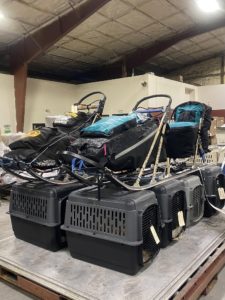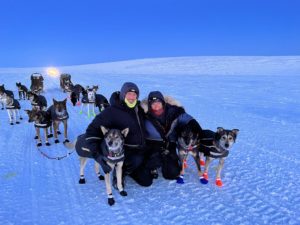Jeff’s Iditarod-2022
The Ceremonial Start was absolutely fantastic! After missing this event in ’21 with Covid, mushers and fans were thrilled to be back running through Anchorage. AND, we had a blizzard! The snow dumped on us, starting at about 8 AM, and producing almost 8 inches of snow by 1PM. Some good friends and family showed up to support us and get the team to the start line. Katti had our good friend and kennel assistant, Lindsey, drive her tag sled. I had my longtime friend, Isaac, driving my tag sled. It was great!
As I thought about the race itself, and our teams and strategy, the thought of not finishing never crossed my mind. This was my sixth Iditarod. I have run enough of these now to know how to make it through. Katti had been training our dogs with me for years, and is a competent and experienced musher. Would we meet challenges? Of course! Would things not go as planned? Absolutely! Would we finish? Certainly!

Off the start line, I stuck very close to my pre-determined race plan. The dogs were moving smoothly, and we had decent trail conditions up the rivers and through the Alaska Range. The gorge, always a challenge, kept us on our toes. Braavos, the only dog in our kennel to finish every Iditarod since 2018, took over leading out of Rainy Pass, and immediately made it obvious he was “home,” and going to be taking this team to Nome. He effortlessly crossed flowing creeks, glare ice, and chest deep overflow.
Leaving Rohn and starting across the Farewell Burn, conditions became pretty horrific. The anticipated snow, had long since melted or blown away, and what remained was a ribbon of ice (bordered by stumps, dead trees, boulders and tussocks). Oh, and don’t forget the hills. Steep hills! It was a terrifying experience, and lasted far longer than anticipated. Finally, almost 30 miles out of Rohn, I found a spot with a little snow. This was our place to pull over and take a decent rest. Once the team was fed and comfortably sleeping, I pulled out my InReach (a satellite communication device) and texted Katti, also carrying an InReach. “The Burn is death defying, and should absolutely be treated with respect. I would recommend running the dogs on necklines from mile 8 to mile 25.” Necklines would limit the dogs physical ability to pull so hard, and give added control to the musher. “Ok, good luck.” I know, a terrible message to send, right?!
The remainder of the run to Nikolai improved, but only marginally. It was icy and rough, and then the moguls started. In years with heavy snow, the IronDog snowmachine race destroys the conditions as they follow the Iditarod Trail to Nome. Because their race runs only a couple of weeks in front of us, there is usually not enough time for new snow to fill in their “trench.” That trench, this year, was especially bumpy and deep after their tracks had churned across at speeds of 80 to 100 miles per hour. And so, we would bump in these conditions for the next 350 miles.
My competitive goals started to fade after returning Marten and Qarth from the trail. These two boys have been solid race leaders over the years, and Qarth, in particular, is my closest companion out on the trail. Leaving him was not entirely unexpected (he had suffered multiple strains to his shoulder this season), but combined with Marten, it hurt. I tried not to let their departure get me down (too much), and continued looking to all of the promising members still in the team. Braavos was having his best race to date. Kobuk, his son, was loving the trail and running strong in swing. Lynx was on her third Iditarod, and absolutely tearing up the trail. We can still do this!

Our 24 hour rest was a mess! The snow/rain started dumping almost immediately after our arrival, and continued throughout the entire day of rest. This meant it was almost impossible to keep sleds and gear dry. Dog massage and in depth healthcare was doable, but miserably wet (for me and the dogs). We made the best of it, however, and felt pretty good as we packed up for our departure.
The run to Ophir was decent, and the air temperature was starting to drop. It was still snowing, but the intensity was letting up. Our rest would not be long here, and was interrupted repeatedly as teams took off down the trail (parking was somewhat of a cluster). As I analyzed the team, it was apparent that Wolf had strained something in his groin, and would need to fly home. Hvitserk, my most voracious eater (and most “happy go lucky” team member), had a strain to his right triceps. It seemed minor, and I thought there was a chance he might recover (a bit of a long shot in my experience, but worth a shot). We departed Ophir onto a slow and sugary trail, and worked our way towards Cripple.
Within 15 miles of leaving Ophir, Hvitserk started a minor head bob. That shoulder was sensitive and he was adjusting his gait accordingly. Time for him to get in the sled and enjoy a free ride. Damn! I was now running nine dogs, hauling a 60 pound Hvitserk, and had over 70 miles until the next checkpoint. It was now time to rethink this race.
Arriving into Cripple in 18th, I bedded everyone down, fed, and acknowledged that a top ten race was out of the question at this point. At a minimum, my weaker team members needed a 12 hour rest and a few massage sessions. If I wanted to ensure a finish, and successfully get my Dad’s ashes to Nome, we had better rest a little longer. And, if we are going to stay here for 16 hours, why not stay for 36 and run with Katti? Makes sense right? Well, this logic meant that I would be “crashing” Katti’s solo race. And when she finally pulled into Cripple, I can’t say that she was too thrilled to see me. As a matter of fact, I believe her words were, “What the hell are you doing here!?”
In the end, I think we both really enjoyed the experience of traveling the second half of the race together. We got to talk about the trail, the wind, and our young dogs. I could give her my insights to upcoming sections, and she could relay her highlights and accomplishments of the previous run. It was all working out. Not as planned, but we were enjoying the journey none-the-less. And then, we departed White Mountain.

This final run over the Topkok Hills, and along the Bering Sea coast, has been a game changer for many people over the years. We have witnessed Jeff King lose his chance at a fifth victory after being blown out to sea. We have rallied for Aliy to make it to the finish line first, only to be beat out by Dallas who miraculously appears out of the white. I have had fellow racers lose the trail and need rescue from the National Guard after finding themselves surrounded by feet of roiling saltwater. I have witnessed a good friend have his team finally throw in the towel and sit down 13 miles from the finish. And then, watch that same friend get in front of his leaders and walk the final stretch of trail, guiding the team through a 40 mile an hour crosswind. The old saying, “its not over, til its over,” certainly rings true here. And this year, Katti and I got to experience that reality.
There is a fine line in mushing between fun and terror. I have certainly experienced that line before, and come out on the other side unscathed. As we entered the Topkok Hills, and started traversing the glare-ice mountain slopes, I again found that line. I was thrilled! In a brief reprieve from what I would estimate to be a 60 mile an hour “breeze,” I walked back to check in with Katti. “This is now the toughest mushing I have ever done!” I gave her a high-five. She was scared.
And it as at this point that I should have “woken up” and either turned us around (a tough call based on the wind we had already mushed through), or found shelter (not much available). Instead, I urged us on. We could, after all, still keep our sleds upright (most of the time). Soon, however, the wind became so intense that communicating with Braavos was next to impossible, and if I turned around to check in on Katti’s progress, the shift in weight sent us tumbling off course. This was getting out of hand. At one point, as we crossed a wind-blown drainage, the team and I went sailing down-mountain almost 50 yards (simply skating on glare ice until we could get our toes onto something solid, that wasn’t ice). Now, with no trail in sight, and a surge of wind at 70 miles an hour (estimating here), we needed to get back to our trail (AKA scratch marks from other teams in front of us). Without hesitation, I ran to the front of the team and pointed Braavos in the right direction. Doing my best to make it back to the sled, I regained control and pushed forward. Braavos dug in and brought us uphill, into a headwind, across snow so windblown it was like slick tile. I was too much in a mindset of survival to fully appreciate his determination in that moment. But looking back on our final run of Iditarod 2022, this three minute segment really stands out- This 55 pound Alaskan Husky just giving everything he’s got to get to the Nome. Not because I want it. But because he wants it. He has the desire to get to that finish line as much as I do. More, probably. And that drive and love for being out there, and that determination to finish, that is what will keep me running dogs and racing for years to come.


